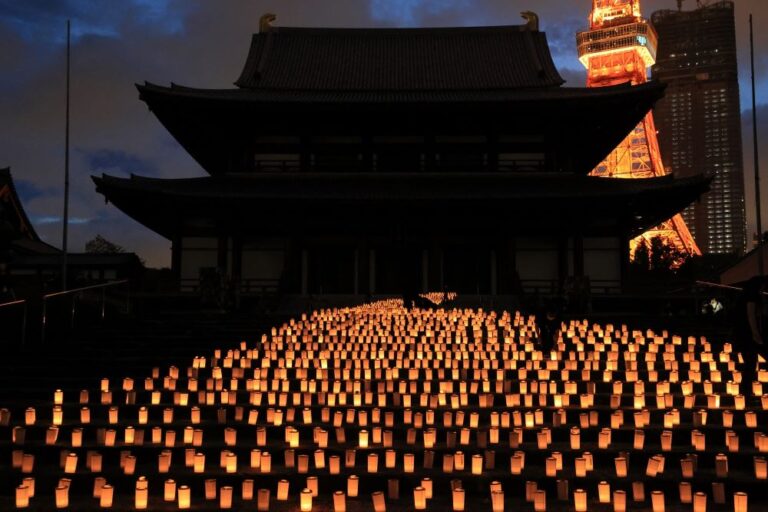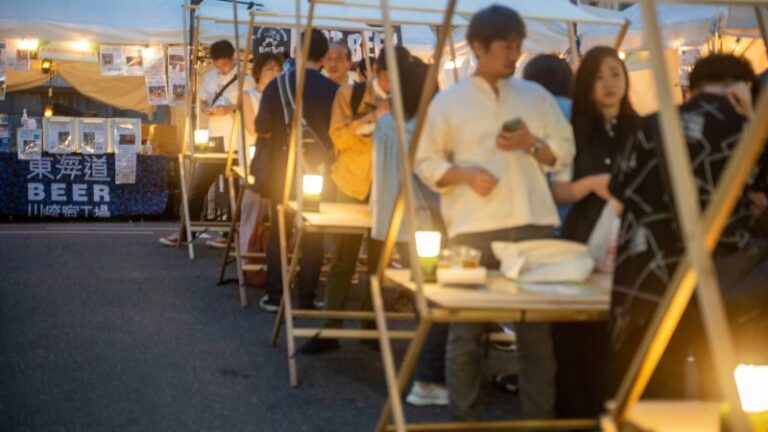One of the definitive events of Tokyo’s summer season, the Mitama Festival will be held on July 13 to 16th and is a spectacle worth experiencing. Starting in 1947, the festival was born out of ancient Japanese beliefs and has since been ingrained into the city’s cultural fabric.

The Yasukuni Shrine is a place of great significance in Japan due to its rich history, profound purpose, and intense political controversy. However, during a few nights every summer season people from all walks of life come together to celebrate the fabulous Mitama Festival – an event that honors ‘mitama,’ or ‘the soul of a deceased person’ in Japanese.
This extraordinary festival pays tribute to those individuals who lost their lives for Japan and serves as one among numerous stepping stones towards Obon: A significant occurrence within Japanese culture wherein they pay homage to ancestors who have passed away.

Despite differing political positions, everyone can set aside their differences and fully relish this amazing occasion.
The Tokyo Obon Festival: A Unique Summer Experience
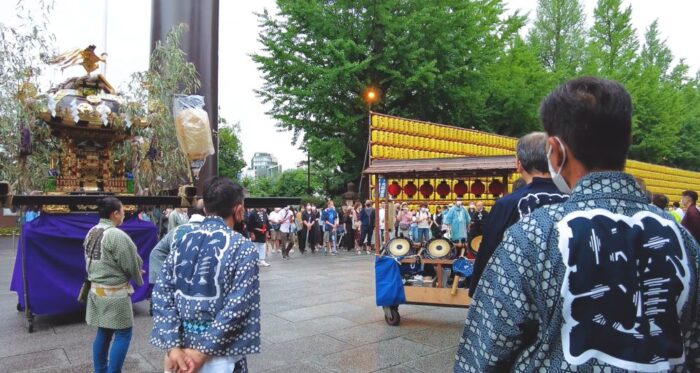
The Tokyo Obon festival has been a staple since 1947 and is considered one of the most significant celebrations in Tokyo. From July 13 to July 16 every year, visitors can immerse themselves in traditional Japanese culture with an impressive lineup of performances within the shrine area.
However, due to its non-weekend dates, scheduling conflicts may arise. But don’t let that stop you from experiencing this annual event. The daytime events feature traditional dancers and taiko drumming enthusiasts who put on spectacular shows for all attendees.
In addition to cultural performances, food stalls offer local cuisine alongside carnival-like games for prizes – making it quite comprehensive compared with other festivals out there. You’ll even find a haunted house on-site if you’re feeling brave enough.
Festival Dancing
One highlight includes team dancing around another circular stage led by skilled performers engaging visitors avidly into joining them, and trust us when we say that it’s just simple fun yet so memorable at once. Don’t miss your chance to attend this unique summer experience during your trip to Japan.
Night Activities

As night falls, a stunning display comes to life at this festival. The exciting energy surges through the main road of the shrine adorned with over 30,000 exquisite yellow lanterns that light up like a dream world come true.
Moving among crowds witnessing passionate chanting and applause is awe-inspiring as groups transport portable Shinto shrines called mikoshi while accompanied by marching bands playing Japan’s national anthem.
One cannot miss out on experiencing the gigantic torii gate entrance where two spotlights dazzle your senses even more effectively. This event leaves attendees feeling deeply emotional and connected – its significance marks it out from other Japanese celebrations which are joyous but lack meaningful sentiment.
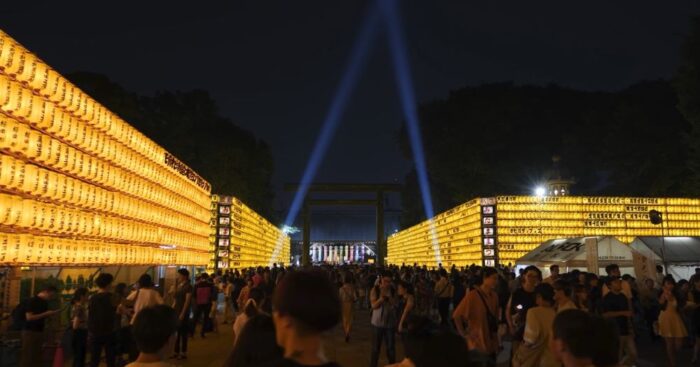
While the festival may not boast as many activities as some other festivals, there is an undeniable atmosphere that immerses visitors in all things Japanese. The festival takes place at Tokyo’s Yasukuni Shrine and honors over 2 million war dead with around 30,000 lanterns illuminating the shrine grounds each night during its four-day run each July.
Visitors can marvel at traditional taiko drumming performances or partake in prayer rituals alongside locals dressed head-to-toe in yukata robes—the perfect chance to learn more about this fascinating culture without breaking the bank (admission is free.).
A Spectacle of Lanterns

During the festival, Yasukuni Shrine’s grounds play host to over 30,000 lanterns, casting a warm and enchanting light across the venue. Adding to the spectacle, lanterns hand-painted by distinguished individuals from various fields are displayed, contributing to the event’s artistry and spiritual significance.
Events and Ceremonies
The festival’s heart lies within its ceremonial rites that aim to comfort the spirits of the departed. These ceremonies are held at the shrine’s main hall each night of the festival, adding a profound spiritual depth to the occasion.
But it’s not all solemn and spiritual. The festival is also known for its festive parades, including the energetic Mikoshi procession, and the vibrant Aomori Nebuta floats. There’s even a special floral dedication exhibit and a variety of traditional performances to keep you entertained.
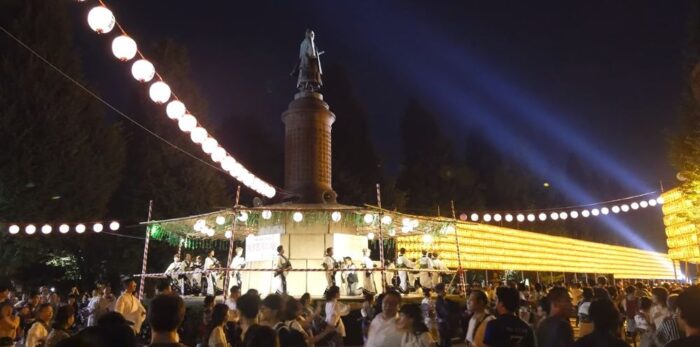
The avenue bathed in the glow of lanterns becomes the stage for Bon dancing. The sight of festival-goers dancing in sync, coupled with the lively night market stalls, evoke a nostalgic atmosphere akin to traditional Japanese festivals.
Mitama Matsuri Festival Schedule
The Mitama Matsuri takes place over a period of four days, from July 13th to July 16th. The specific schedule for each day is as follows:
July 13th
- The festival begins with a pre-celebration at 5 p.m. at the main shrine.
- At 11:30 a.m., there’s a performance by Edo art group “Sakuragawa Pin-sukenaka” starting from the shrine gate, along the approach to the front of the worship hall.
- At approximately 6:40 p.m., the Senju Wind Orchestra parade kicks off from the first torii gate, again following the approach to the front of the worship hall.
- At 7 p.m., there’s a dedication performance by the voluntary members of the Japan Singers Association at the Noh theater.
- At 8:30 p.m., the Sukyo Mahikari youth team performs a five-color drum show in front of the assembly hall.
July 15th
- At 3:30 p.m., there’s another performance by Edo art group “Sakuragawa Pin-sukenaka” from the shrine gate to the front of the worship hall.
- At 6:30 p.m., a Mikoshi procession, organized by “Omotoyama Zojoji Kumano Mikoshi Lecture,” proceeds from the first torii gate to the front of the worship hall.
- At 7 p.m., there’s a special outdoor concert by Hiro Tsunoda at the Noh theater.
- At 8 p.m., Awa Dance by “Kita no Mikado Ren & Kagurazaka Kagura Ren” takes place in front of the shrine gate.
July 16th
- At 6:30 p.m., another Mikoshi procession, this time by “Kojimachi Yasukuni Lecture,” starts from the first torii gate and goes to the front of the worship hall.
- At 8 p.m., the Aomori Nebuta by “Tokyo Nebuta Rengo Association” proceeds from the first torii gate to the front of the worship hall.
These events and their timing may be subject to change. The festival grounds, including the Noh theater, host various dedication performances from around 10 a.m. to approximately 8 p.m. every day.
The lanterns on the shrine grounds and calligraphy snow caves will be lit from July 13th to 16th until 9:30 p.m. Food will be available from kitchen cars on-site (but no stalls).
Directions
The Mitama Festival (Mitama Matsuri) takes place at Yasukuni Shrine in Tokyo. Here are some directions:
By Train:
- From Tokyo Station: Take the JR Chuo Line (Rapid) to Ochanomizu Station. From Ochanomizu Station, take the Tokyo Metro Marunouchi Line to Kudanshita Station. Yasukuni Shrine is about a 5-minute walk from Kudanshita Station.
- From Shinjuku Station: Take the Toei Shinjuku Line directly to Kudanshita Station. Yasukuni Shrine is about a 5-minute walk from Kudanshita Station.
On Foot:
If you’re nearby and prefer to walk, the shrine is about a 10-minute walk from Iidabashi Station, and also a similar distance from Ichigaya Station.
Address:
Yasukuni Shrine, 3-1-1 Kudankita, Chiyoda City, Tokyo 102-8246, Japan.
Please remember to check the local transit websites for any changes in the schedules or routes. And, as always, please respect the shrine and its grounds during your visit. Enjoy the festival.
The Sum Up
Embrace the joyous celebration of summer at the Mitama Festival, where ancient customs meet the buzz of a modern metropolis. With its colorful lanterns, spiritual ceremonies, and vibrant festivities, it offers visitors an authentic slice of Japanese culture, right in the heart of Tokyo.
Where To Stay In Tokyo
Tokyo visitor levels are currently at an all-time high so make sure to book your hotels early. Tip most hotels booked with booking.com have free cancelation so book as soon as you know your date and you can always cancel if you change your mind.



